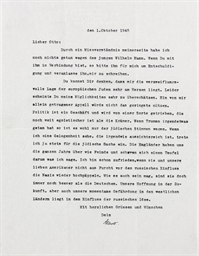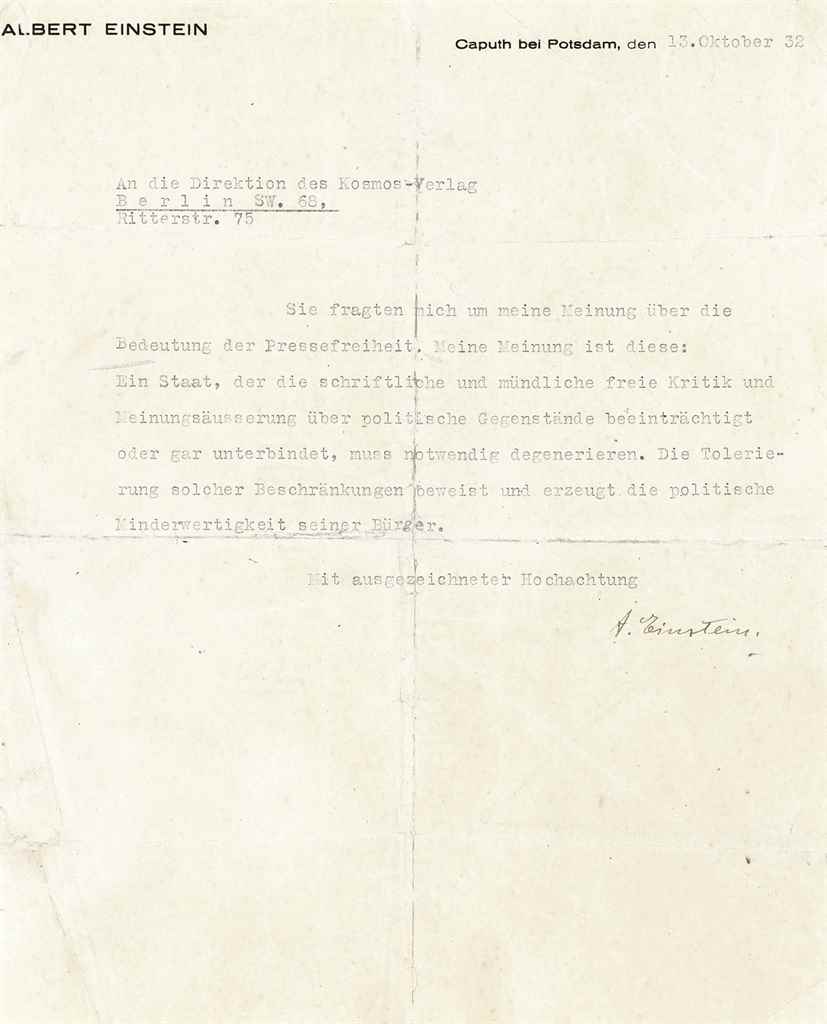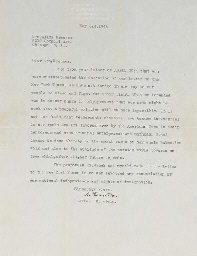EINSTEIN, ALBERT. Typed letter signed ("A. Einstein"), to the physicist Robert S. Shankland, Chairman of the Physics Dept., Case Institute of Technology, Princeton, 29 October 1952. 1 page, 4to, embossed stationery . "Dear Dr. Shankland, your resume does not correspond exactly with the thoughts I was endeavouring to express. I am sending you therefore something what [ sic ] I could have said on the occasion..." -- EINSTEIN. Typed statement DESCRIBING THE INFLUENCE OF MICHELSON AND OTHER PHYSICISTS ON THE ORIGIN OF THE THEORY OF RELATIVITY. [Princeton, 29 October 1952]. 1 full page, 4to, embossed stationery . -- EINSTEIN. Autograph scientific diagram relating to Michelson's experiment, the top portion (statistics) in Shankland's hand, n.p., 25 May 1921 (according to Shankland's pencilled note), 1 page, in pencil . With a copy of Shankland's letter of 27 October 1952. Together three items . THE "MOST CRUCIAL STATEMENT EINSTEIN EVER MADE ON THE ORIGINS OF THE SPECIAL THEORY OF RELATIVITY" (A. PAIS) An historic statement--deceptively terse in its wording--constituting Einstein's definitive statement on the origins and scientific antecedents of his Special Theory of Relativity, especially the possible influence of the controversial Michelson-Morley experiments. Dr. Shankland, a physicist, had questioned Einstein on the subject in discussions in February 1950 and again on 24 October 1952. Initially, Shankland, reported, Einstein insisted he had heard of the experiment "after 1905," in other words, after he had formulated the theory; in his second response to Shankland, Einstein stated that Michelson-Morley's experiment had not consciously influenced him, but in the years 1905-1909, "he thought a great deal about Michelson's result, in his discussion with Lorentz and others ... about general relativity. He then realized ... that he had also been conscious of Michelson's result before 1905 partly through his reading of the papers of Lorentz and more because he had simply assumed this result of Michelson to be true" (Shankland, quoted in Pais, Subtle is the Lord...': The Science and the Life of Albert Einstein , p. 117). In his letter to Einstein, Shankland had sent a passage summarizing what Einstien had said to him regarding Michelson, which he planned to use in a talk in honor of the 100th anniversary of Michelson's birth. The present is Einstein's carefully composed statement. "I always think of Michelson as the Artist in Science. His greatest joy seemed to come from the beauty of the experiment itself, and the elegance of the method employed. But he has also shown an extraordinary understanding for the baffling fundamental questions of physics. This is evident from the keen interest he has shown ... for the problem of the dependence of light from motion. The influence of the crucial Michelson-Morley experiment upon my own efforts has been rather indirect. I learned of it through H.A. Lorentz's decisive investigation of the electrodynamics of moving bodies (1895) with which I was acquainted before developing the special theory of relativity. Lorentz's basic assumption of an ether at rest seemed to me not convincing in itself and...it was leading to an interpretation of the result of the Michelson-Morley experiment which seemed to me artificial. What led me more or less directly to the special theory of relativity was the conviction that the electro-motoric force acting on a body in motion in a magnetic field was nothing else but an electric field. But I was also guided by the result of the Fizeau-experiment and the phenomenon of aberration. There is, of course, no logical way leading to the establishment of a theory but only groping constructive attempts controlled by careful consideration of factual knowledge." A number of historians and scientists have studied the origins of Einstein's most famous theory; all refer to the Einstein-Shankland exchanges (which were published in the American Journal of Physics , 31:47 and 32:16).
EINSTEIN, ALBERT. Typed letter signed ("A. Einstein"), to the physicist Robert S. Shankland, Chairman of the Physics Dept., Case Institute of Technology, Princeton, 29 October 1952. 1 page, 4to, embossed stationery . "Dear Dr. Shankland, your resume does not correspond exactly with the thoughts I was endeavouring to express. I am sending you therefore something what [ sic ] I could have said on the occasion..." -- EINSTEIN. Typed statement DESCRIBING THE INFLUENCE OF MICHELSON AND OTHER PHYSICISTS ON THE ORIGIN OF THE THEORY OF RELATIVITY. [Princeton, 29 October 1952]. 1 full page, 4to, embossed stationery . -- EINSTEIN. Autograph scientific diagram relating to Michelson's experiment, the top portion (statistics) in Shankland's hand, n.p., 25 May 1921 (according to Shankland's pencilled note), 1 page, in pencil . With a copy of Shankland's letter of 27 October 1952. Together three items . THE "MOST CRUCIAL STATEMENT EINSTEIN EVER MADE ON THE ORIGINS OF THE SPECIAL THEORY OF RELATIVITY" (A. PAIS) An historic statement--deceptively terse in its wording--constituting Einstein's definitive statement on the origins and scientific antecedents of his Special Theory of Relativity, especially the possible influence of the controversial Michelson-Morley experiments. Dr. Shankland, a physicist, had questioned Einstein on the subject in discussions in February 1950 and again on 24 October 1952. Initially, Shankland, reported, Einstein insisted he had heard of the experiment "after 1905," in other words, after he had formulated the theory; in his second response to Shankland, Einstein stated that Michelson-Morley's experiment had not consciously influenced him, but in the years 1905-1909, "he thought a great deal about Michelson's result, in his discussion with Lorentz and others ... about general relativity. He then realized ... that he had also been conscious of Michelson's result before 1905 partly through his reading of the papers of Lorentz and more because he had simply assumed this result of Michelson to be true" (Shankland, quoted in Pais, Subtle is the Lord...': The Science and the Life of Albert Einstein , p. 117). In his letter to Einstein, Shankland had sent a passage summarizing what Einstien had said to him regarding Michelson, which he planned to use in a talk in honor of the 100th anniversary of Michelson's birth. The present is Einstein's carefully composed statement. "I always think of Michelson as the Artist in Science. His greatest joy seemed to come from the beauty of the experiment itself, and the elegance of the method employed. But he has also shown an extraordinary understanding for the baffling fundamental questions of physics. This is evident from the keen interest he has shown ... for the problem of the dependence of light from motion. The influence of the crucial Michelson-Morley experiment upon my own efforts has been rather indirect. I learned of it through H.A. Lorentz's decisive investigation of the electrodynamics of moving bodies (1895) with which I was acquainted before developing the special theory of relativity. Lorentz's basic assumption of an ether at rest seemed to me not convincing in itself and...it was leading to an interpretation of the result of the Michelson-Morley experiment which seemed to me artificial. What led me more or less directly to the special theory of relativity was the conviction that the electro-motoric force acting on a body in motion in a magnetic field was nothing else but an electric field. But I was also guided by the result of the Fizeau-experiment and the phenomenon of aberration. There is, of course, no logical way leading to the establishment of a theory but only groping constructive attempts controlled by careful consideration of factual knowledge." A number of historians and scientists have studied the origins of Einstein's most famous theory; all refer to the Einstein-Shankland exchanges (which were published in the American Journal of Physics , 31:47 and 32:16).















Testen Sie LotSearch und seine Premium-Features 7 Tage - ohne Kosten!
Lassen Sie sich automatisch über neue Objekte in kommenden Auktionen benachrichtigen.
Suchauftrag anlegen